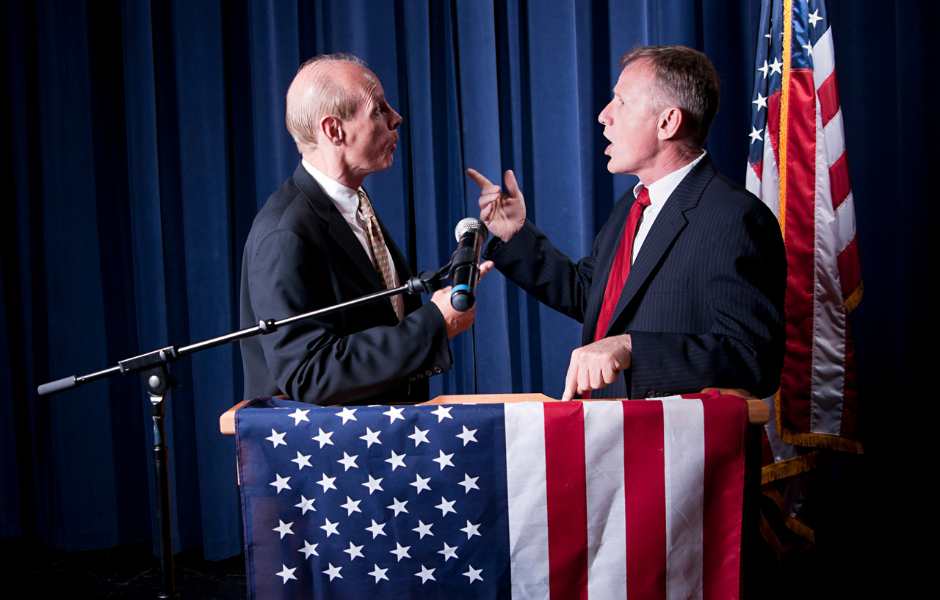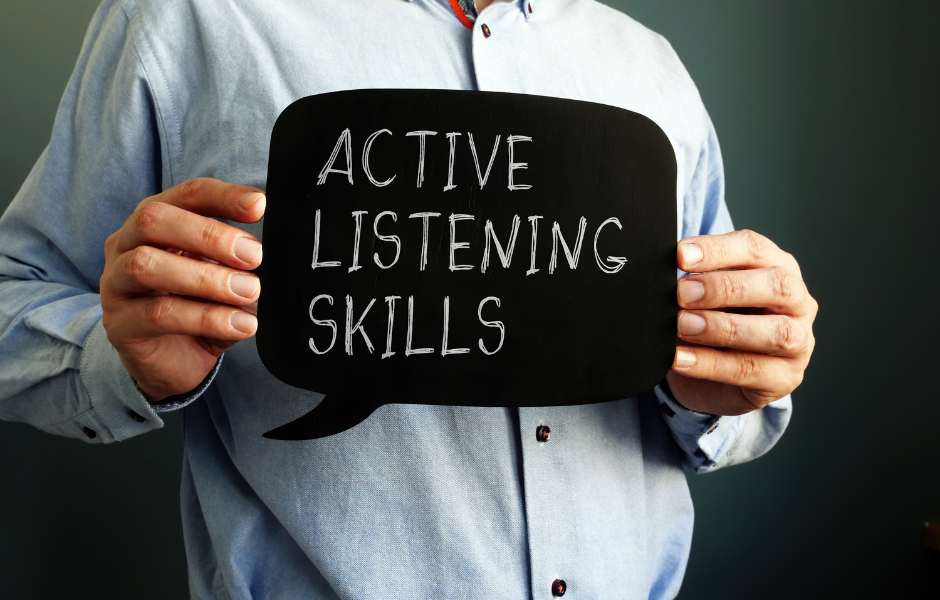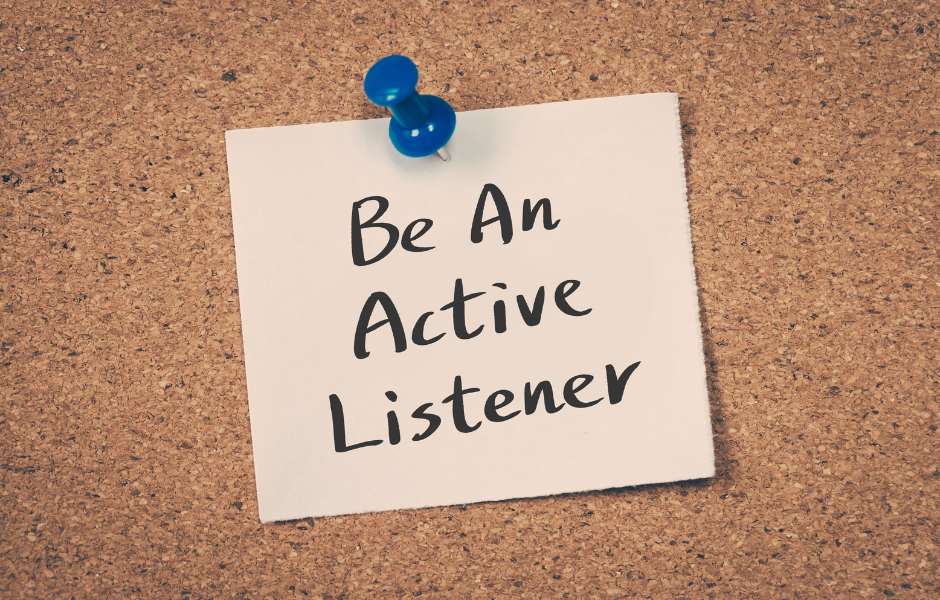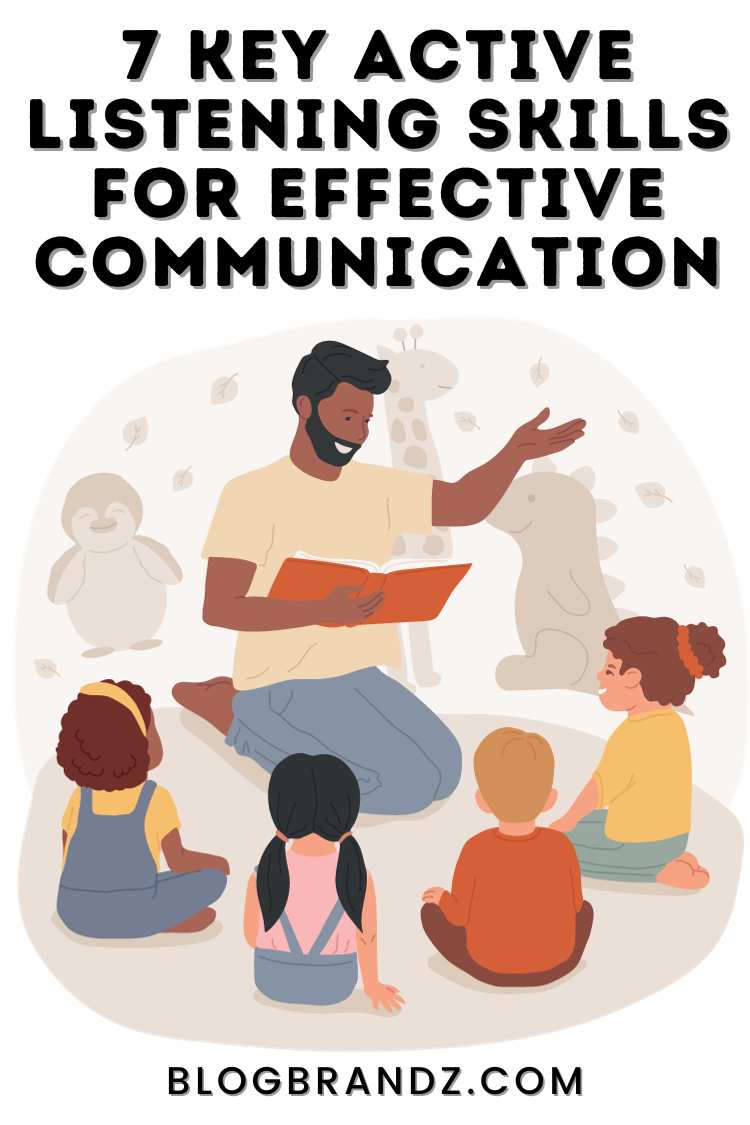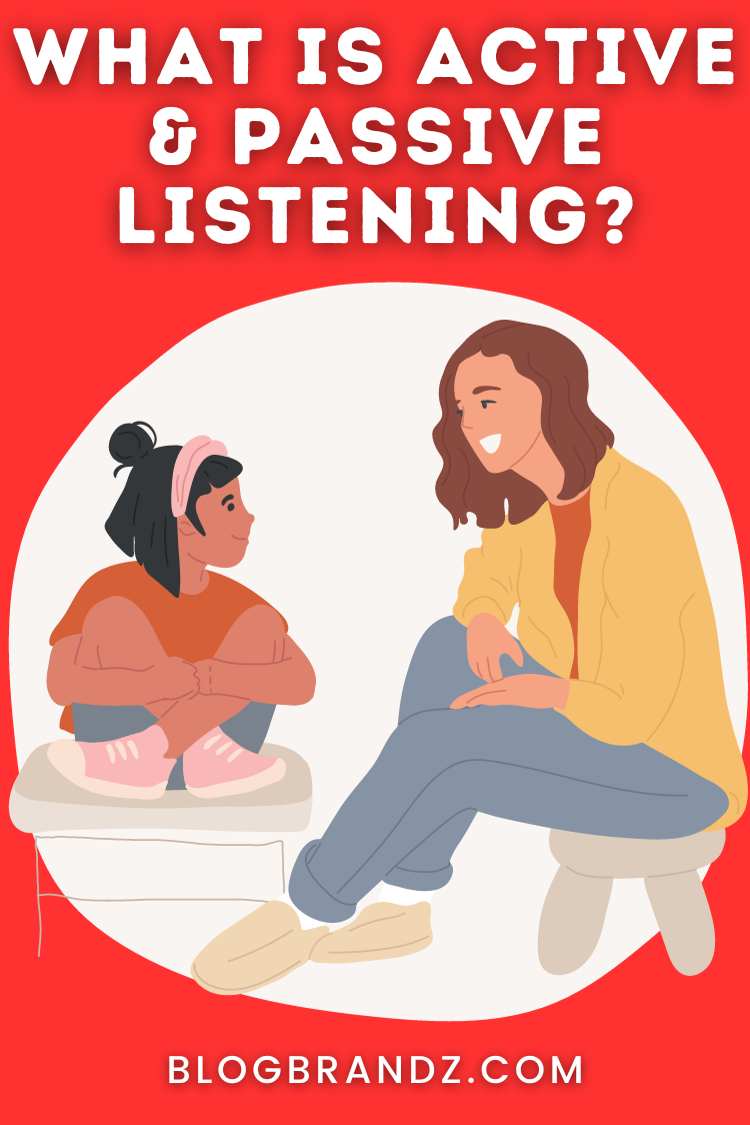Learn how to improve your communication and active listening skills to foster deeper understanding and supercharge your coaching results.
Good listening skills in communication play a pivotal role in facilitating meaningful and productive dialogues, enhancing understanding, and fostering effective collaboration among team members.
But what makes listening so monumental, you ask? Well, it’s the unsung hero of communication, the backbone of our exchanges with the world.
Picture this: in the bustling tapestry of our daily routines, we devote about nine percent of our precious time to writing, 16 percent to reading, 30 percent to talking, and a staggering 45 percent to listening.
In the vibrant tapestry of human interaction, the art of active listening stands as an irreplaceable cornerstone. It’s the secret sauce that transforms ordinary conversations into profound connections, enabling us to truly understand and be understood.
Within the intricate dance of active listening, we find three distinct stages: hearing, attention, and understanding. In this exploration, we journey through the nuances of these stages, unraveling the techniques that elevate us from passive listeners to virtuosos of the listening craft.
It doesn’t matter if you’re an astrophysicist unraveling the secrets of the universe or a barista crafting the perfect latte – understanding the art of listening is your passport to success. Now, let’s delve into the secrets of this captivating communication skill.
You see, it’s not just about ears perking up; it’s about understanding the intricate dance of communication, recognizing the barricades that obstruct our receptivity, and mastering the art of active listening.
“One of the most sincere forms of respect is actually listening to what another has to say.” ~ Bryant McGill
Contents
Active Listening: Definition
Active listening, meaning a communication technique where the listener fully engages in the conversation, focusing their attention on the speaker, and demonstrating their understanding and interest through various verbal and non-verbal cues.
It involves giving the speaker feedback, asking clarifying questions, and empathizing to ensure a deeper comprehension of the speaker’s message, fostering effective and meaningful communication.
To define active listening – it is a pivotal component of various types of listening skills, encompassing attentive and empathetic engagement with the speaker to foster understanding and effective communication and build rapport.
So, brace yourself, for we’re about to embark on a journey into the profound world of listening and communication skills.
Click here to preview Esther Perel’s MasterClass
3 Crucial Stages of Listening
Listening, my friends, is not a mere passive act of hearing; it’s a finely tuned process, an intricate dance between our senses and our minds. In the realm of effective communication, understanding the three stages of this process is akin to wielding a powerful secret weapon.
#1. Hearing
Imagine your mind on a stage, where the curtains rise when sound waves hit the stage. This is the first act, where sound transforms into electric impulses, making its way to your consciousness.
It’s the foundation upon which the symphony of listening is built, but it’s only the opening chord. Think of a crowded cafe, where the hum of conversation, clinking glasses, and the hiss of the espresso machine all merge into a cacophony.
Amidst this auditory storm, you hear your friend’s voice calling your name. That’s hearing!
#2. Attention
Here’s where things get interesting. To truly listen, you must direct the spotlight of your attention onto the stage.
It’s like trying to follow a captivating story in a noisy room; distractions lurk everywhere, from external noises to the constant buzz of your thoughts. Yet, by consciously focusing, you create a space for meaningful dialogue.
Imagine you’re in that cafe again. This time, as your friend speaks, you actively tune out the surrounding noise, honing in on their words.
You make a conscious effort to set aside your internal chatter about what you’ll order next or your weekend plans. That’s attention!
#3. Understanding
This is the crescendo, the apex of the listening symphony. It’s not just about grasping the words; it’s about immersing yourself in the message.
To truly understand, you must decipher not only the literal meaning but also the context, and the subtle cues in the speaker’s tone, expression, and body language.
A bit of background knowledge about the subject or the speaker can also be your guiding star. Picture your friend now, sharing their excitement about a new business venture.
You not only hear their words but also sense their passion in the animated gestures, the sparkle in their eyes, and their earnest tone. You connect the dots, understanding not just the what but the why. That’s understanding!
So, remember that the journey from hearing to understanding is a path paved with intention and focus. To truly master the art of listening, one must embrace each of these stages, transforming mere sounds into the rich tapestry of human communication.
The Barriers to Effective Listening
Listening, the cornerstone of effective communication, often faces formidable foes that lurk in the shadows, ready to thwart our ability to truly connect.
As coaches and trainers, understanding these barriers is not just a skill but a superpower that can transform the way we impart knowledge.
#1. Psychological Barriers
Picture a mental fortress, fortified with prejudice, apathy, and fear. These are the guardians of our minds, ever vigilant against the invasion of new ideas and information.
For instance, a marketing guru might not be as enthralled by annual financial results as their accountant counterpart, given the perceived disconnect from their daily endeavors.
Imagine you’re conducting a workshop on financial planning, and you notice a few participants checking out mentally.
Their preconceived notions about finance being dry and uninteresting form a psychological barrier. Overcoming this requires unraveling the complexities and making it relatable.
#2. Physical Barriers
Sometimes, the body rebels against the mind’s intent to listen. Disability, fatigue, or health issues can be the invisible shackles that hinder comprehension.
Trying to absorb a speaker’s wisdom while nursing a head cold is akin to scaling a mountain with a backpack full of bricks. During a crucial team meeting, a team member, battling fatigue from a restless night, struggles to stay attentive.
Physical exhaustion acts as a barrier, making it challenging to fully grasp the discussion. Recognizing such barriers allows for adjustments, like shorter meetings or providing breaks.
#3. Environmental Barriers
Think of the environment as the backdrop of our listening stage. Distracting noises, uncomfortable seating, or a stifling meeting room climate can hijack our attention and derail even the most engaging presentations.
In a boardroom packed with echoing voices and the constant hum of air conditioning, your voice as a trainer becomes a mere whisper. Environmental barriers demand proactive measures, such as finding quieter spaces or optimizing seating arrangements.
#4. Expectation Barriers
Our minds are storytellers, and they love to predict the future. Expecting mundane or confusing content, bracing for bad news, or anticipating a barrage of bewildering jargon can barricade us from the actual message.
As you begin a lecture on quantum physics, some students groan at the prospect of an impenetrable sea of equations and theories. Their expectation of complexity forms a barrier.
To break through, you must demystify the subject, aligning it with their curiosity. In the realm of work or education, tackling tangible barriers like the environment or physical discomfort is a straightforward task.
However, conquering the internal obstacles demands a more strategic approach. It involves meticulous preparation, addressing preconceived notions, and creating an atmosphere that fosters receptivity.
By dismantling these barriers, you unlock the true potential of effective listening and the transformative power of communication.
Unlock True Understanding with Active Listening
Listening, my friends, is not a one-size-fits-all affair. It comes in different flavors, each with its own set of characteristics and implications. Let’s dive into this auditory spectrum and explore the crown jewel of them all: active listening.
#1. Competitive Listening
Ever witnessed two politicians fiercely debating, each waiting for their turn to pounce? That’s competitive listening in action.
In this scenario, the listener is more interested in seizing the microphone of conversation, eager to voice their perspective as soon as their counterpart falls silent. Alternatively, their thoughts wander to crafting their rebuttal, leaving the current speaker in the lurch.
Picture a high-stakes business negotiation where egos clash. Instead of absorbing their counterpart’s proposals, both parties are mentally drafting counterarguments, creating a conversational tug-of-war.
#2. Passive or Attentive Listening
In a lecture hall, you might find rows of attentive students diligently taking notes, but there’s little room for interaction.
This is passive listening, where the audience absorbs information but lacks a meaningful opportunity to engage with the speaker.
It’s like reading a book – you’re absorbing the content, but the author remains blissfully unaware of your comprehension.
For example, during a captivating TED talk, the audience hangs on to every word, but the speaker can’t gauge individual comprehension or address questions in real-time.
#3. Active Listening
Now, let’s unveil the hero of our tale. Active listening goes beyond mere attention; it seeks to unearth the genuine message beneath the words. It’s about displaying visible interest in what the speaker is conveying and actively engaging with them.
Whether you’re a manager, salesperson, or trainer, active listening is your golden ticket, especially in informal training settings like coaching and mentoring.
For example, imagine you’re mentoring a junior colleague, and they’re sharing their career aspirations. Instead of passively nodding, you delve deeper, asking probing questions, and offering insights.
You’re not just hearing; you’re connecting on a deeper level. In the world of communication, active listening is the secret sauce that brings forth true understanding. It’s a dance of curiosity, empathy, and engagement.
As you embark on this journey, remember that active listening isn’t just a solo act; it’s an invitation for others to join the dance of understanding.
So, whether you’re a mentor guiding the way or a learner absorbing wisdom, embrace the power of active listening to foster genuine connections and unlock the riches of meaningful dialogue.
7 Key Active Listening Skills
Active listening involves several key skills that help individuals engage effectively in conversations and understand others. While the specific number of skills may vary depending on the source, here are seven commonly recognized active listening skills:
- Attentive Silence: Being quiet and attentive while the speaker is talking, allowing them to express their thoughts without interruption.
- Paraphrasing: Restate the speaker’s message in your own words to demonstrate understanding and confirm accuracy.
- Reflecting Feelings: Recognizing and acknowledging the speaker’s emotions, showing empathy and empathy.
- Asking Open-ended Questions: Encouraging the speaker to elaborate and share more information by posing questions that cannot be answered with a simple “yes” or “no.”
- Summarizing: Recapping the main points of the conversation to ensure clarity and confirm that you’ve grasped the key ideas.
- Non-Verbal Cues: Using body language, eye contact, and facial expressions to convey interest and attentiveness.
- Empathetic Responses: Expressing understanding and empathy by acknowledging the speaker’s perspective and emotions.
These active listening skills collectively help create a supportive and effective listening environment, fostering better communication and connection between individuals.
Mastering the Art of Active Listening
To truly embrace active listening, it’s crucial to break it down into its fundamental stages: hearing, attention, and understanding.
Let’s explore some effective communication techniques to elevate your active listening skills within each of these realms, enabling you to become a true virtuoso of the listening craft.
#1. Hearing and Attention
By mastering the art of ceasing our own chatter, battling distractions, and employing non-verbal cues, we lay the foundation for truly attentive listening.
- Cease the Chatter: It may seem obvious, but it bears repeating: when you aim to listen actively, silence your own voice. Stop talking and create the space for the speaker to express themselves.
- Battle Distractions: Wage war on distractions, both external and internal. Eliminate external disruptions as best as you can, find a quiet space, and silence your devices. Internally, clear your mental clutter; be present in the moment.
- Master Non-Verbal Signals: Your body language speaks volumes. Maintain eye contact with the speaker, adopt an open stance, and use encouraging non-verbal cues such as nodding or smiling. These signals convey your genuine interest and willingness to engage.
#2. Understanding
Listening is more than the absence of noise; it’s the presence of understanding. Aligning our purpose, strategic note-taking, thoughtful questioning, and the transformative power of reflection elevate us to the summit of comprehension.
- Purpose Alignment: Understand the speaker’s purpose and clarify your objectives for the conversation. This alignment ensures that the dialogue remains on track and meaningful.
- Strategic Note-Taking: While taking notes can be valuable, focus on jotting down keywords and phrases that trigger your memory later. Avoid the pitfall of trying to transcribe every word; it may distract from the essence of the message.
- Ask Thoughtful Questions: If the opportunity arises, ask questions. Refer to your notes to seek clarification on points that may need further explanation. However, be mindful not to interrupt the speaker’s flow; wait for appropriate pauses.
#3. The Power of Reflection
This technique, commonly used in consultative selling but applicable across various fields, elevates your understanding to another level. It involves communication on three levels: facts, thoughts, and feelings.
- Parroting Facts: Repeat the facts you believe you’ve gleaned from the speaker. This not only validates your comprehension but also ensures that you’re on the same page.
- Share Thoughts and Beliefs: Articulate the thoughts and beliefs you’ve perceived. This goes beyond parroting; it demonstrates your engagement at a deeper level.
- Convey Emotions: Delve into the realm of emotions. Express empathy or sympathy when appropriate, understanding and reflecting the speaker’s emotional state. This distinguishes true reflection from mere repetition and fosters a more meaningful connection.
This arsenal of active listening techniques isn’t limited to coaching or mentoring; it’s your key to effective communication in business, education, training, or any realm where understanding the core of a message is paramount.
8 Ways to Improve Your Listening Skills
Improving your listening skills is a valuable skill that can enhance your communication and relationships. Here are eight ways to improve listening skills in communication:
- Stay Focused: Give your full attention to the speaker and minimize distractions. Put away your phone, close unnecessary tabs on your computer, and find a quiet environment if possible.
- Maintain Eye Contact: Maintain appropriate eye contact to show that you’re engaged and interested in what the speaker is saying.
- Avoid Interrupting: Resist the urge to interrupt or finish the speaker’s sentences. Let them express themselves fully before responding.
- Practice Patience: Allow the speaker to speak at their own pace. Don’t rush them or become impatient, even if you think you know what they’re going to say.
- Use Non-Verbal Cues: Employ non-verbal cues like nodding and smiling to convey your understanding and interest.
- Ask Clarifying Questions: If you’re unsure about something the speaker said, ask open-ended questions for clarification. This shows that you’re actively listening and trying to comprehend.
- Avoid Judging: Try to suspend judgment and refrain from forming opinions or making assumptions while listening. Be open to different perspectives.
- Practice Reflective Listening: Summarize or paraphrase what the speaker has said to confirm your understanding and show that you’re actively engaged in the conversation.
Remember that improving your listening skills is an ongoing process. Regularly practicing these techniques can help you become a more effective and empathetic listener.
Whether you’re navigating a performance review or facilitating a critical conversation, these communication techniques will help you elevate your active listening prowess and forge stronger connections with those around you.
In IBM’s People and Soft Skills for Professional and Personal Success Specialization, you’ll learn how to harness active listening and adept questioning techniques to dissect challenges, foster comprehension, and unravel dilemmas.
Effective listening skills are essential for building strong relationships and improving communication in both personal and professional settings. In the grand symphony of human connection, active listening is the conductor’s baton that orchestrates harmony.
Whether you’re guiding a mentorship, engaging in a crucial business discussion, or nurturing relationships, these communication techniques will be your guiding stars.
Embrace the art of active listening, and let it be the bridge that connects you to the hearts and minds of those around you, fostering a deeper understanding that transcends mere words.
Coaching & Mentoring Tips
- Jack Canfield’s Train the Trainer Online
- How To Become a Chief Training Officer (CTO)
- Become a Coach with Coaching Training & Certification
- How to Be a Great Mentor and Sponsor in The Workplace
- E-Training Tips to Create an Engaging Virtual Learning Environment
- How To Start An Online Training Institute & Sell Online Courses
- How to Build Good Relationships as a Success-Driven Entrepreneur
- Learn Soft Skills & Personality Development for the Future of Work
- How to Overcome Speech Anxiety & Learn the Art of Public Speaking
- Personal Branding for Coaches: How Do I Market My Coaching Business?
© 2023 – 2024, Priya Florence Shah. All rights reserved.
Priya Florence Shah is a bestselling author and an award-winning blogger. Check out her book on emotional self-care for women. Priya writes short stories and poetry and chills with her two-legged and four-legged kids in her spare time.
Discover more from Business & Branding Tips
Subscribe to get the latest posts sent to your email.








